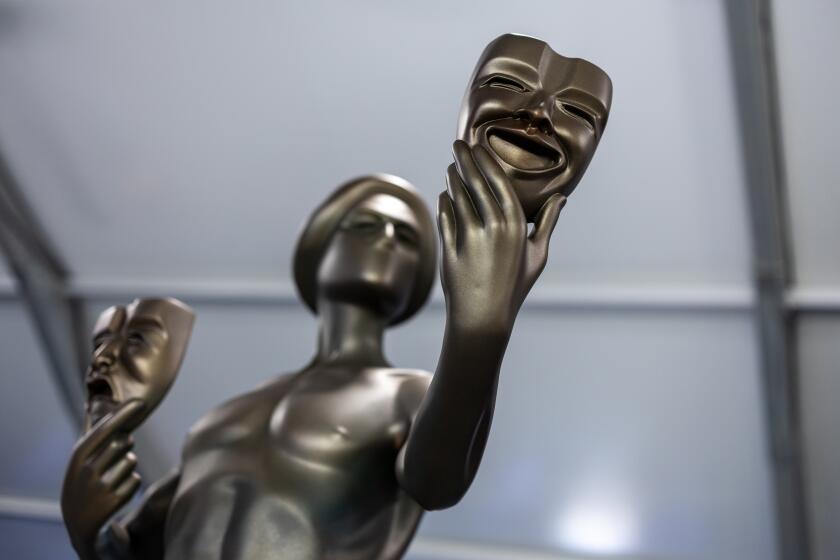‘Frozen’ fervor heats up Disney’s quarterly profit
- Share via
Walt Disney Co.’s animated blockbuster “Frozen” may have debuted in theaters more than a year ago, but the film still remains a major profit driver for the Burbank entertainment giant.
Consumers have snapped up dolls, wigs, T-shirts and anything else linked to the hit 3-D film that follows the adventures of princesses Elsa and Anna — making “Frozen” the top-selling toy brand last year. That has translated to big money.
The fervor helped Disney’s consumer products division score record results during the company’s fiscal first quarter, when operating profit increased 46% to $626 million from the year-ago period. That helped push Disney’s overall profit up 19% to $2.2 billion during the period that ended Dec. 27.
“‘Frozen’ is poised to be the gift that keeps on giving,” said Tuna Amobi, an S&P Capital IQ analyst. “It really raises the bar for what they can do with any given franchise. We may have only scratched the surface of what ‘Frozen’ can do.”
Amobi said he was surprised by the holding power of the “Frozen” franchise. The film, which debuted in November 2013 and grossed more than $1.2 billion in theaters, has spun off a popular video game that boosted the interactive division’s quarter, and increased revenue at the studio through the sale of DVDs and digital copies of the film. Both of those divisions notched double-digit operating profit growth.
Disney Chairman and Chief Executive Robert Iger told Wall Street analysts on a conference call that “Frozen” merchandise should also get a boost when a short film featuring the characters from the original movie debuts in front of the company’s new live-action version of “Cinderella” in March.
“Now, a full year after its release, we’re seeing the true impact of ‘Frozen’ across our entire company,” he said.
Disney, the world’s largest entertainment and media company, posted a profit of $1.27 a share — easily surpassing analysts’ projections of $1.08 a share, according to investment research firm Zacks. Revenue jumped 9% to $13.4 billion during the quarter.
Investors did not appear bothered that Disney’s media networks division, which is the company’s biggest unit and controls ESPN and other television networks, posted only modest gains during the period. Within the division, the cable group’s operating profit was down 2% to $1.26 billion. Disney partly attributed that decline to higher programming and production costs at ESPN.
Shares jumped 4% in after-hours trading on Tuesday to $97.70, and looked set to bust through the stock’s 52-week high of $96.43. The stock closed the regular session at $94.10.
A challenge down the road for Disney will be finding a replacement for “Frozen” and the revenue it generates, said entertainment industry analyst Harold Vogel.
“They need, of course, another big hit to start comparing against it, because it is very profitable,” he said. “It is something that they will be able to handle because they have so many other things going on.”
Indeed, Jay Rasulo, the company’s finance chief, noted on the conference call that “Frozen” is just one of 11 Disney brands that deliver more than $1 billion in annual retail sales. He said that the launch of Disney’s first “Star Wars” film in December would also expand the company’s consumer products business.
Another big driver during Disney’s quarter was its parks and resorts unit, which posted a 20% gain in operating profit to $805 million.
Disney said the strong performance was partly due to increased guest spending at its domestic parks, where attendance rose 7% during the quarter.
The division was also the subject of major news: Iger said that the company’s forthcoming Shanghai Disney Resort — which was expected to open at the end of this year — would instead debut in spring 2016. Last year it was announced that Disney and its Chinese partner on the multibillion-dollar project would spend an additional $800 million on it as part of an expansion plan.
Iger called the development “a very large, fairly complicated project — one of the largest we’ve ever engaged in, probably one of the largest ever in China.”
Analysts don’t expect the delay to negatively affect the parks and resorts division’s financial outlook next year.
Iger painted a rosy picture for the future of the parks, touting positive reviews of MyMagic+, a bracelet embedded with a radio frequency identification (RFID) device that has been offered to parkgoers in Walt Disney World in Orlando, Fla.
The bracelet offers Fast Pass capabilities for rides, and can be used in place of an admission ticket and credit card. Disney officials have said that MyMagic+ would be rolled out at other parks and resorts over the next few years.
“And what this all adds up to is our ability to manage more people at a time without in any way diminishing guest experience,” Iger said.
Times staff writer Hugo Martin contributed to this report.
More to Read
From the Oscars to the Emmys.
Get the Envelope newsletter for exclusive awards season coverage, behind-the-scenes stories from the Envelope podcast and columnist Glenn Whipp’s must-read analysis.
You may occasionally receive promotional content from the Los Angeles Times.









